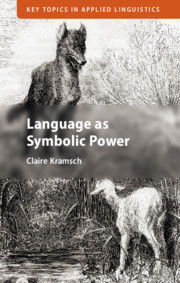Book contents
- Language as Symbolic Power
- Key Topics in Applied Linguistics
- Language as Symbolic Power
- Copyright page
- Contents
- Figures
- Acknowledgments
- Introduction
- Part I The Power of Symbolic Representation
- Part II The Power of Symbolic Action
- Part III The Power to Create Symbolic Reality
- 7 “I Am Seen and Talked About, Therefore I Am”
- 8 Language as Symbolic Power in the Digital Age
- 9 Engaging with Symbolic Power—Responding to Symbolic Violence
- Conclusion
- Glossary
- Endnotes
- References
- Index
7 - “I Am Seen and Talked About, Therefore I Am”
from Part III - The Power to Create Symbolic Reality
Published online by Cambridge University Press: 15 October 2020
- Language as Symbolic Power
- Key Topics in Applied Linguistics
- Language as Symbolic Power
- Copyright page
- Contents
- Figures
- Acknowledgments
- Introduction
- Part I The Power of Symbolic Representation
- Part II The Power of Symbolic Action
- Part III The Power to Create Symbolic Reality
- 7 “I Am Seen and Talked About, Therefore I Am”
- 8 Language as Symbolic Power in the Digital Age
- 9 Engaging with Symbolic Power—Responding to Symbolic Violence
- Conclusion
- Glossary
- Endnotes
- References
- Index
Summary
Taking as a point of departure a 2016 report in the media of the fatal shooting of a gorilla in the Cincinnati zoo and its transformation into a meme that went viral on the Internet, I consider some of the post-modern theories that explain the effect of digital technology and social media on the way such incidents are socially constructed. I compare the way parents and friends read the incident and college students interpreted it. I discuss Foucault’s notion of disciplinary society, Debord’s spectacle society and Baudrillard’s concept of hyper-reality and simulacrum from the 1970s and 1980s. I show how today these concepts have been supplemented by Harcourt’s notion of expository society that prizes visibility, normativity and veridiction. I show how today, Anderson’s notion of imagined community, born in an era of nationalism, has been supplanted by a kind of conviviality typical of social media in our era of globalization. This conviviality is accompanied by what Ferraris and Martino call “documediality,” the power of the Web to archive and disseminate verbal, visual and audio documents over the Internet in viral fashion. Digital communication is today a crucial aspect of the use of language as symbolic power.
Keywords
- Type
- Chapter
- Information
- Language as Symbolic Power , pp. 135 - 153Publisher: Cambridge University PressPrint publication year: 2020



